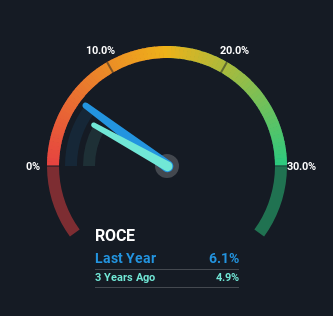Hiwin Technologies' (TWSE:2049) Returns On Capital Not Reflecting Well On The Business

If we want to find a stock that could multiply over the long term, what are the underlying trends we should look for? Firstly, we'd want to identify a growing return on capital employed (ROCE) and then alongside that, an ever-increasing base of capital employed. Basically this means that a company has profitable initiatives that it can continue to reinvest in, which is a trait of a compounding machine. In light of that, when we looked at Hiwin Technologies (TWSE:2049) and its ROCE trend, we weren't exactly thrilled.
Return On Capital Employed (ROCE): What Is It?
For those who don't know, ROCE is a measure of a company's yearly pre-tax profit (its return), relative to the capital employed in the business. To calculate this metric for Hiwin Technologies, this is the formula:
Return on Capital Employed = Earnings Before Interest and Tax (EBIT) ÷ (Total Assets - Current Liabilities)
0.061 = NT$2.7b ÷ (NT$51b - NT$8.0b) (Based on the trailing twelve months to December 2023).
So, Hiwin Technologies has an ROCE of 6.1%. Ultimately, that's a low return and it under-performs the Machinery industry average of 8.3%.
View our latest analysis for Hiwin Technologies

Above you can see how the current ROCE for Hiwin Technologies compares to its prior returns on capital, but there's only so much you can tell from the past. If you'd like, you can check out the forecasts from the analysts covering Hiwin Technologies for free.
What The Trend Of ROCE Can Tell Us
On the surface, the trend of ROCE at Hiwin Technologies doesn't inspire confidence. To be more specific, ROCE has fallen from 21% over the last five years. And considering revenue has dropped while employing more capital, we'd be cautious. If this were to continue, you might be looking at a company that is trying to reinvest for growth but is actually losing market share since sales haven't increased.
On a related note, Hiwin Technologies has decreased its current liabilities to 15% of total assets. So we could link some of this to the decrease in ROCE. Effectively this means their suppliers or short-term creditors are funding less of the business, which reduces some elements of risk. Some would claim this reduces the business' efficiency at generating ROCE since it is now funding more of the operations with its own money.
The Bottom Line On Hiwin Technologies' ROCE
In summary, we're somewhat concerned by Hiwin Technologies' diminishing returns on increasing amounts of capital. Despite the concerning underlying trends, the stock has actually gained 13% over the last five years, so it might be that the investors are expecting the trends to reverse. Regardless, we don't like the trends as they are and if they persist, we think you might find better investments elsewhere.
Hiwin Technologies does have some risks though, and we've spotted 1 warning sign for Hiwin Technologies that you might be interested in.
For those who like to invest in solid companies, check out this free list of companies with solid balance sheets and high returns on equity.
Valuation is complex, but we're here to simplify it.
Discover if Hiwin Technologies might be undervalued or overvalued with our detailed analysis, featuring fair value estimates, potential risks, dividends, insider trades, and its financial condition.
Access Free AnalysisHave feedback on this article? Concerned about the content? Get in touch with us directly. Alternatively, email editorial-team (at) simplywallst.com.
This article by Simply Wall St is general in nature. We provide commentary based on historical data and analyst forecasts only using an unbiased methodology and our articles are not intended to be financial advice. It does not constitute a recommendation to buy or sell any stock, and does not take account of your objectives, or your financial situation. We aim to bring you long-term focused analysis driven by fundamental data. Note that our analysis may not factor in the latest price-sensitive company announcements or qualitative material. Simply Wall St has no position in any stocks mentioned.
About TWSE:2049
Hiwin Technologies
Manufactures and sells motion control and systematic technology products.
Flawless balance sheet with moderate growth potential.
Similar Companies
Market Insights
Community Narratives




